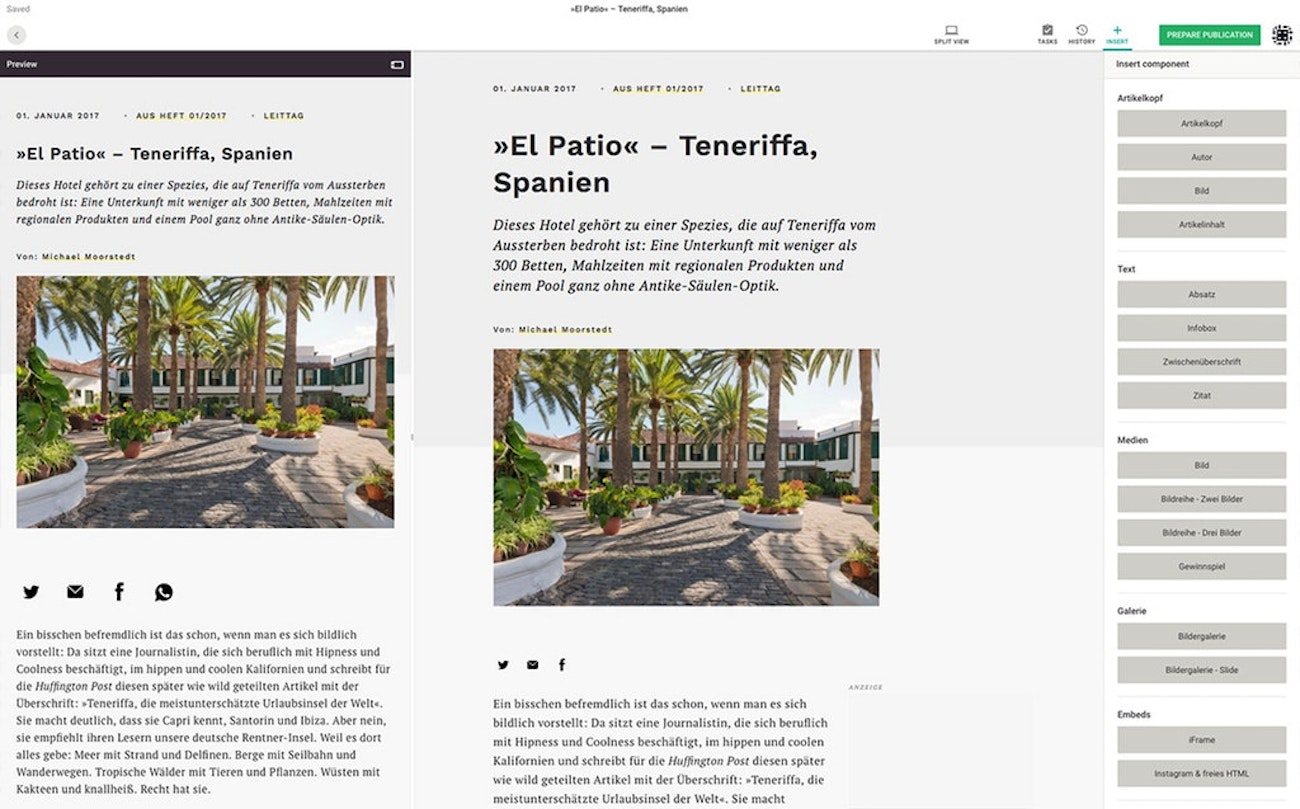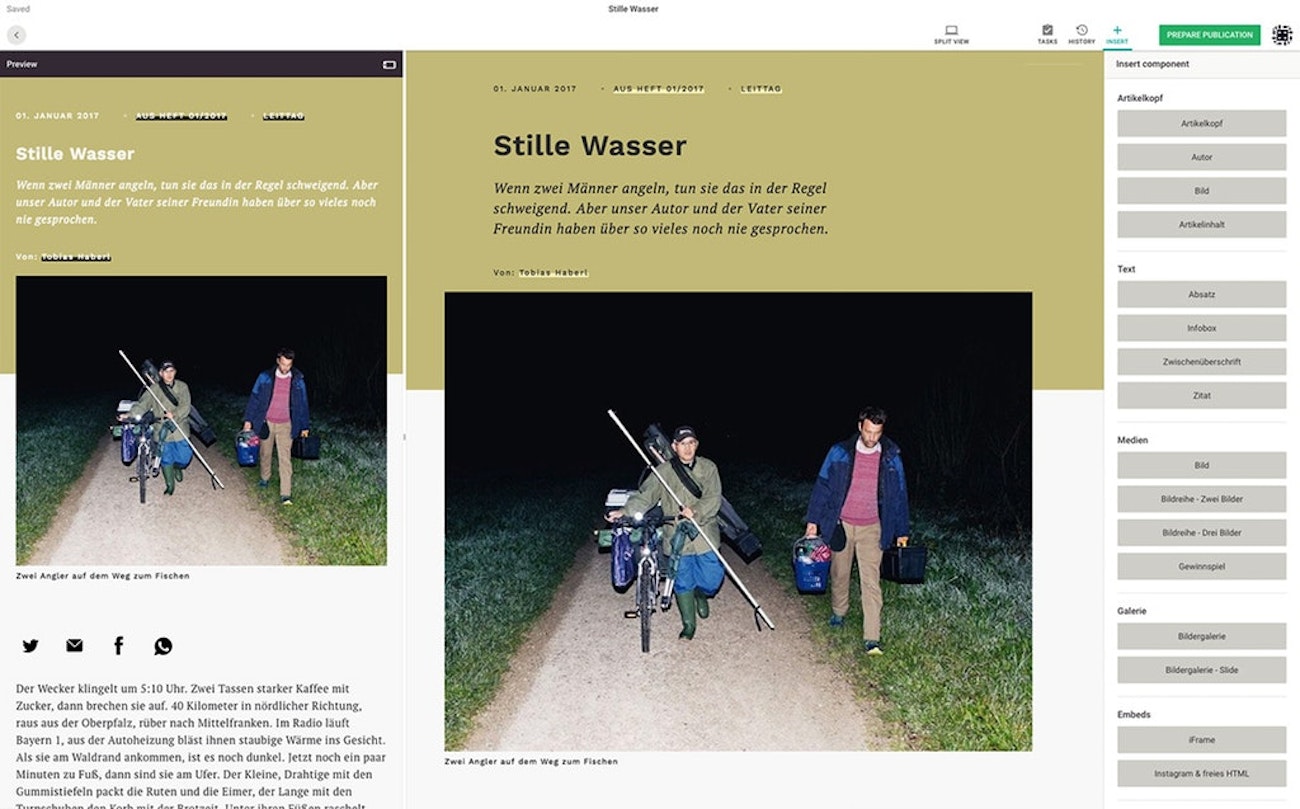Süddeutsche Zeitung Magazin
Discovering a brand new experience
Süddeutsche Zeitung (SZ) is one of Germany’s leading quality newspapers. They have one of the most innovative developer teams across news corporations. They use it to leverage their position as technological frontrunners and to support the journalistic quest to make complex matters easy to grasp. One of their most famous recent projects is the visualization of the insights out of the Paradise Papers.
SZ also issues the biggest magazine of all German daily newspapers. Unlike other newspaper weeklies, the SZ Magazin is positioned as a product in its own right, with a homepage of its own.
Goals
-
Easy onboarding of novices
-
Components for their microservice strategy
-
Latest web tech that developers love to work with
-
Possibility to customize
Results
-
Intuitive WYSIWYG editor makes onboarding a breeze
-
Livingdocs headless approach: components can easily be removed or added
-
State of the art environment with Node.js and Javascript throughout the whole stack
-
Well-documented libraries and APIs that allow plugging in the client’s own solutions
Leaving the old world
We wanted an intuitive system that a newcomer would immediately understand.

Judith Gerber,
Productmanager SZ
Since the early 2000s, SZ Magazin developers and journalists had worked with an editor they had built themselves. With further outlets such as a digital edition in a mobile app joining the traditional print edition, a separate editing system was deployed. After this expansion, workflows urgently needed streamlining. In order to make the online version of the magazine more attractive, the journalists also wanted to produce additional articles exclusively for online. Yet there was a catch: «The editorial team plainly stated that producing this online-only content additionally with the old inconvinient system would be inefficient and not productive», recalls project manager Judith Gerber. «So we needed something new and innovative. But at the same time we needed to keep all operating journalists on board with the change – juniors and seniors. We wanted an intuitive system that a newcomer would immediately understand.»


Magazine articles are either imported from the print system or written originally in Livingdocs. The editor allows journalists an easy way to create content and see how it works on the web and on different devices.
Looking for new land
The developer team evaluated options. They needed a powerful and flexible editor, because web technology develops quickly, and to keep up their high editorial and technological standards, they needed to move at the same pace. A while ago, they therefore had agreed on a «microservice strategy» that requires important technological components to be updatable independently. Livingdocs with its modular approach provided a clear advantage over other content-creation systems running at the SZ publishing group, such as Apostrophe. Livingdocs empowers the customer to come up with their own mix of tools that best fits their needs. Livingdocs’ software components can be flexibly rearranged – either taken out, or enriched with custom modules. This allows customers to develop independently, and release faster and more efficiently.
We could start running super quickly.

Judith Gerber,
Productmanager SZ
The evaluation team arrived at two options: Either build their own system again, or use Livingdocs. The developers built a prototype and presented it to the editorial team next to Livingdocs. While the journalists liked both, the technical crew paced ahead. They were eager to have a working system as soon as possible – and thus voted for Livingdocs. «We could start running super quickly», Judith Gerber points out.
The journalists had a long wish list of features. Yet when they produced two magazine editions online in parallel to their normal workflow, it turned out that many features on the list could be skipped. «It’s actually impossible to describe a new workflow theoretically», says Judith Gerber. «People are always anxious to forget something. The best way is to just try the new system in practice.»
SZ uses Livingdocs solely for online production, either imported from print or originally created for online. They wanted a system that integrates with their existing infrastructure consisting of a print system and a unified delivery for all online products.
First steps on a new continent
They said: 'This is so much better than our old system. Can we please have it right away and start working with it?

Judith Gerber,
Productmanager SZ
Soon the minds of editors and developers were eased. Not only was the new system running. The best part for project manager Gerber was the support her team got from the journalists. «They said: 'This is so much better than our old system. Can we please have it right away and start working with it?'» One feature they loved was that they could just drag and drop images from their desktop into the article they were producing.
Editors now worked much faster. Articles from the magazine’s other editorial system could be imported automatically with a tool that SZ developed and plugged into Livingdocs. When finalizing the release of the new editor, SZ and Livingdocs developers communicated through a dedicated Slack channel. That worked well, reports developer Thomas König, who partook in evaluating Livingdocs and integrating it into the SZ Magazin’s technical ecosystem. «When we had urgent questions, we got answers very quickly.» Communicating through this dedicated channel is a plus for König: «Usually, people hesitate to contact developers. With Slack this felt much more natural, because you know that there is always somebody on the other end who is happy to answer.» The release for the new editor was completed well on time, and within budget.
The future looks bright
Livingdocs is just fun to work with. We love programming in node.js because it is modern web technology.

Thomas König,
Developer SZ-Magazin
The cherry on top, according to developer König: «Livingdocs is just fun to work with. We love programming in node.js because it is modern web technology.» Adding their own tools, such as the customized importer, was supported very well by Livingdocs APIs and libraries, and «felt very natural, not like a hack», says König.